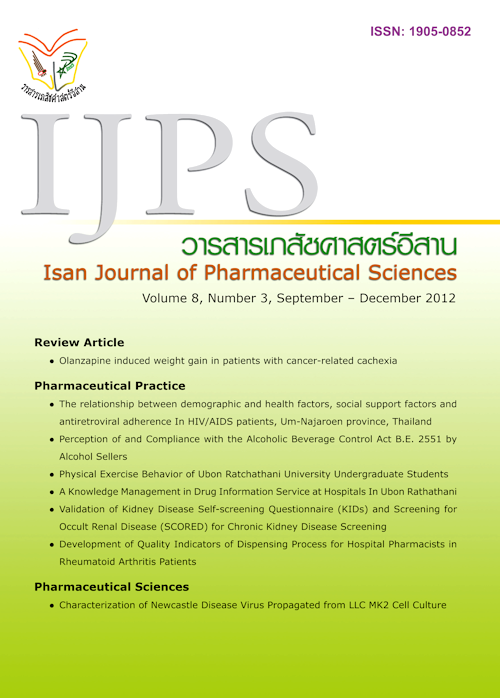Characterization of Newcastle Disease Virus Propagated from LLC MK2 Cell Culture
Main Article Content
Abstract
Introduction: Newcastle disease virus (NDV) strain LaSota is commonly used as a vaccine strain for live vaccines. The virus is commonly cultivated from specific pathogen-free embryonated eggs. Propagation of the virus in cell culture is an alternative for vaccine production. The objective of this study was to investigate the differentiation of NDV propagated from LLC MK2 cell culture. Methods: Reverse Transcription-Polymerase Chain Reaction (RT-PCR) was used to prepare the fusion (F) gene of the adapted virus. Splenocyte proliferation and specific antibody response in immunized BALB/c mice were studied. Results and Discussion: The F gene of the adapted virus was still of lentogenic strain. Two-point mutations on the DNA sequences of the virus were observed without a change in amino acids. The virus could stimulate splenocyte proliferation and induce an increase of serumIgG2a and IgG2b levels similar to those of the NDV from embryonated eggs. Conclusion: The adapted virus from LLC MK2 cells could be used as antigen for a live vaccine.
Article Details
In the case that some parts are used by others The author must Confirm that obtaining permission to use some of the original authors. And must attach evidence That the permission has been included
References
Abbas AK, Lichtman AH. Basic Immunology; Functions and disorders of the immune system. 2nd ed. Elsevier: Philadelphia, 2004.
Estrada A, Katselis GS, Laarveld B, Barl B. Isolation and evaluation of immunological adjuvant activities of saponins from Polygala senega L. Comp Immunol Microbiol Infect Dis 2000; 23(1): 27-43.
German TM, Bongartz H, Dlugonska H. et al. Interleukin-12 profoundly up-regulates the synthesis of antigen-specific complement-fixing IgG2a, IgG2b and IgG3 antibody subclasses in vivo. Eur J Immunol 1995; 25: 823-829.
Henrickson KJ. Parainfl uenza viruses. Clin Microbiol Rev 2003; 16(2): 242-264.Hierholzer JC., Killington RA. Virus isolation and quan-titation. In Mahy BWJ, Kangro HO. editors. Virology methods manual. London: Academic Press; 1996. 205-255.
Ishida M, Nerome K, Matsumoto M, Mikami T, Oya A. Characterization of different tissue cultures for isolation and quantitation of infl uenza and parafl uenza viruses. J Clin Microbiol 1985; 10: 32-36.
Kant A, Koch G, van Roozelaar F, Balk F, Huurne AT. Differentiation of virulent and non-virulent strains of Newcastle disease virus within 24 hours by polymerase chain reaction. Avian Pathol 1997; 26: 837-849.
Kournikakis B, Fildes J. Titration of avirulent Newcastle disease virus by the plaque assay method. J Virol Methods 1988; 20: 285-293.
Leeuw O, Peeters B. Complete nucleotide sequence of Newcastle disease virus: evidence for the existence of a new genus within the subfamily Paramyxovirinae. J Gen Virol 1999; 80: 131-136.
Manosroi A, Saraphanchotiwitthaya A, Manosroi J. Immunomodulatory activities of Clausena excavate Burm. F. wood extracts. J Ethnopharmacol 2003; 89(1): 155-160.
Meydani SN, Ha W. Immunologic effect of yogurt. Am J Clin Nutr 2000; 71(4): 861-872.
Mishra S, Kataria JM, Sah RL, Verma KC, Mishra JP. Studies on the pathogenicity of Newcastle disease virus isolates in guinea fowl. Trop Anim Health Prod 2001; 33: 313-320.
Nagai Y, Klenk H-D, Rott R. Proteolytic cleavage of the viral glycoproteins and its significance for the virulence of Newcastle disease virus. Virol 1976; 72(2): 494-508.
OIE-World Organisation for Animal Health. Newcastle disease [Online]. 2009 Oct [cited 2011 Sept 14]. Available from http://www.oie.int/fileadmin/Home/eng/Animal_Health_in_the_World/docs/pdf/NEWCASTLE_DISEASE__FINAL.pdf.
Orsi MA, Doretto Júnior L, Reischak D, et al. Newcastle disease virus vaccine strains: immunogenicity is not incluenced by ICPI. Braz J Poultry Sci 2009; 11(2): 129-133.
Park M-S, García-Sastre A, Cros JF, Basler CF, Palese P. Newcastle disease virus V protein is a determinant of host range restriction. J Virol 2003; 77(17): 9522-9532.
Porstmann T, Ternynck T, Avrameas S. Quantitation of 5-bromo-2-deoxyuridine incorporation into DNA: an enzyme immunoassay for the assessment of the lymphoid cell proliferative response. J Immunol Methods 1985; 82(1): 169-179.
Sjolander A, van’t Land B, Lovgren Bengtsson K. ISCOMc containing purified Quillaja saponins upregulate both Th1-like and Th2-like immune response. Cell Immunol 1997; 177(1): 69-76.
Steward M, Vipond IB, Millar NS, Emmerson PT. RNA editing in Newcastle disease virus. J Gen Virol 1993; 74: 2539-2547.
Tiwari AK, Kataria RS, Nanthakumar T, Dash BB, Desai G. Differential detection of Newcastle disease virus strains by degenerate primers based RT-PCR. Comp Immunol Microbiol Infect Dis 2004; 27(3): 163-169.


